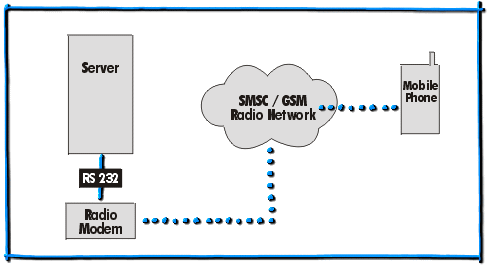

 FaxWare
5
FaxWare
5
SHORT MESSAGE SERVICE (SMS)By means of SMS, you can send written short messages to single or several cellular telephones. Using this service, you can send short messages from FaxWare to a cellular telephone and vice versa. These short messages may be up to 160 characters long. After transmission they can be read on the display of the cellular telephone. This is especially useful for outdoor staff, shipping agencies, taxi companies and maintenance companies for example. Imagine you're away and waiting for an important fax. FaxWare can inform you either automatically about the receipt of the document or even transmit the message directly to the display of your cellular telephone. For example, you can use SMS to send people information which will be directly displayed on their cellular telephones. This could be price quotations, sports results or just your best wishes. All this can be done so conveniently from FaxWare. Think about an application with FaxWare managing the filling level of drinks machines. FaxWare could automatically inform service staff if there were any defects or shortages.áTransmitting
SMS messages
If the cellular telephone to be contacted cannot be reached (for example, if it is switched off), the SMSC will keep trying to reach the cellular telephone for the next 48 hours. After this period, the short message will be deleted by the center.á Generally the SMS center of the radio network carrier passes on the short messages to the recipient within a few seconds. You can even receive SMS messages during a phone call. As soon as a message has arrived, a corresponding notification will be displayed on your cellular phone. You can then display the message immediately or at a later point in time.á It's possible to compress messages too. You can define the maximum compression factor yourself. Compression will only be used to avoid exceeding the maximum length of 160 characters. If you try to send a message with more than 160 characters, the server will automatically carry out a compression.á Currently, there are 4 different compression levels that can be used.á These short mails might look strange, but you can still read them. According to our tests, it's even possible to reduce 500 characters to 150. You can also configure the maximum number of parts into which a mail can be split for transmission.á An abbreviation list, which you can edit individually, is very useful for compression. For example, you can enter "Replace Michael Smith by MS" etc. This list can also be used to take out insignificant information in automated things such as a backup report.á To work with the short message services, you can use any serially controlled radio modem with an SMS command set (AT+Cellular), e.g. Tobit cPort1.á Receiving
SMS messages
With this application, the whole subject of SMS is being given a new meaning. Who says that SMS has just been developed for cellular or mobile phones. SMS is just as useful for fixed non-mobile connections (e.g. file servers). We even suggest that you specify your SMS number(s) on letterhead and business documents in future!á First, you might think that all this is ridiculous. However, we think that it's just great. Safe, fast, and incredibly cheap transmission of messages. For example, this is very interesting for resellers who maintain their customers' PCs. When a modem breaks down, the SMS modem of the customer automatically sends a message to the reseller's SMS modem. Please read the section entitled "New reporting standard" for further information.á |
á
Copyright ⌐ 1998 Tobit Software, Germany. All rights reserved.áAny questions? Feel free to send a mail to wip@troja.com!á
 á
á